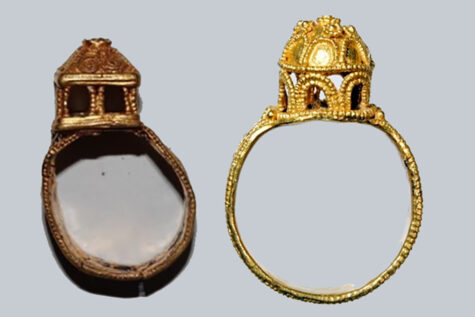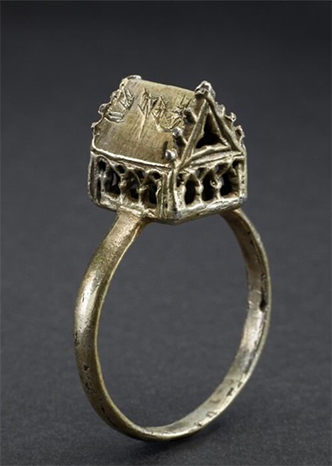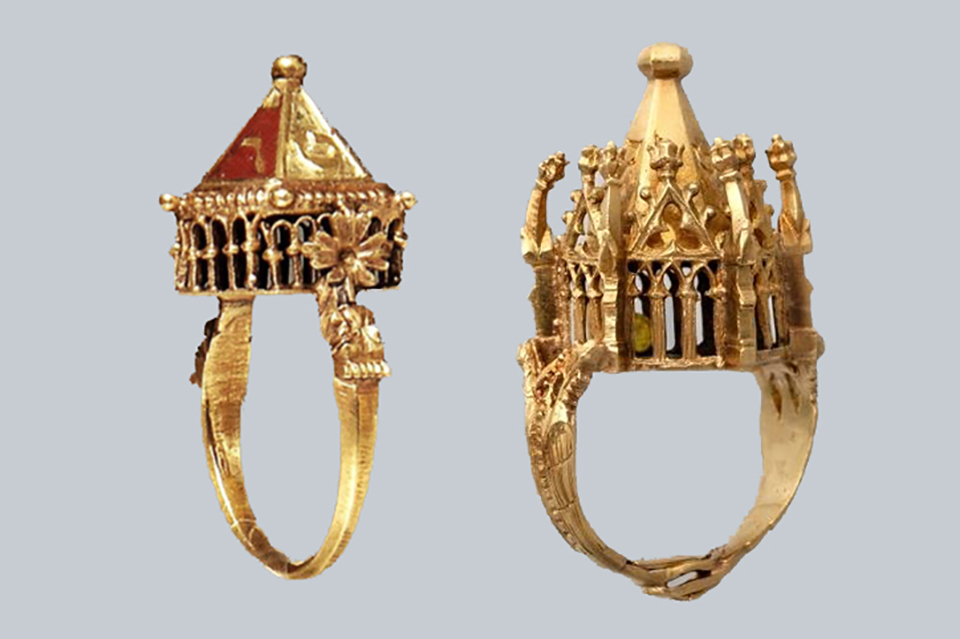One of the exiting finds in the hidden Jewish treasure trove discovered in Erfurt in 1998 was a precious wedding ring featuring an elaborate piece of medieval architecture. What was the symbolic meaning of this?
As in a Christian context, a Jewish marriage would be established by sexual intercourse, contract and/or payment of a bride price, more precisely, a coin. Since the 7th century, this coin was apparently paid in the form of a wedding ring given to the bride in the presence of witnesses. As part of this ceremony, the ring played the role as a visual token, turning the wedding into a legal transaction.
New research by Maria Stürzebecher, author of the main History of the Jews in Erfurt, tells us that such rings had to live up to a certain standard if the transaction was to be claimed legal. Might the ring be made of silver but gold-plated? Or did it have to be made of pure gold? This, the Rabbis might debate since at least the 11th century without reaching a firm conclusion. It appears, though, as if the material performance of any Jewish wedding had to conform to a certain standard to be legal. One condition was that the young man had to own the ring before the actual ceremony. Another of these preconditions was the required visibility – hence size – of the ring in question. Obviously, more ordinary rings would have been used among less affluent Jews. However, size and quality was probably important visual markers.
Architectural Rings

Rings with towers and miniature buildings have been dated to Late Antiquity, with several examples also known from Merovingian times. One such example is the ring from Les-Rues- des-Vignes, now in the Musée de Cambrai. Another is the ring from Brèves, now kept at Clamecy in Nièvre. Reine Hadjadi, in her catalogue (Hadjadi 2007), lists a handful. These rings from the 6th century have been explained as miniature “baptismal rings”, reiterating the form of a baptistery. However, lacking any Christian symbols, this seems farfetched. However, lacking Hebrew inscriptions, they are seen as Byzantine imports.
Stürzebecher names only four medieval rings, which may be definitely identified as Jewish wedding rings by their inscriptions of “Mazal Tow”. The four rings are the Colmar ring from c. 1300, the Erfurt ring dated to 1349, the Weissenfels, c. 1300-1350. Finally, the golden ring from Wittelsbach from ca. 1500. However, in the collections in the Met in NY, a photo of a ring from the 13th to 14th century is found, which also has the identifying inscription. The ring, which is kept in a private collection. Further examples are known from older catalogues, although most of the rings in larger collections were forgeries from the 19th and early 20th centuries. (Mann 2018)

CC BY NC SA 4.0
The bezel of the rings is said to commemorate either the house of the newlyweds, the synagogue or the destruction of the Temple in 70 CE. The early crusaders believed the Dome of the Rock, the polygonal central building on the temple mount from 691 CE, rooted in the Byzantine architectural tradition, to be identical to this building. As such, it entered the visual repertoire of Christian and Jewish illuminated renditions of the Temple of Solomon.
The image of this Temple was used metaphorically to liken the Jewish marriage to the performative rebuilding of this sacred centre of Judaism. “Thus, the wedding can be interpreted as a symbolic rebuilding of the destroyed temple, symbolised by the design of the wedding rings in the form of small temples”, writes Stürzebecher.
One peculiar element – present in two of the five rings – is the little ball lodged inside the “temple” and giving off sounds when the ring was placed on the finger of the bride. Stürzebecher explains the rattling sound as intended to make the ring-giving both visible and oral. However, might it also be a symbolic rendition of the sounding of the shofar and the trumpets accompanying the sacrifice in the second Temple?
FEATURED PHOTO:
Three Jewish Wedding rings. Collage of rings from Colmar and Colmar. Source: Thuringian State Office for Heritage Management and Archaeology/ B. Stefan (CC BY NC SA 4.0).
SOURCES:
Jewish Wedding Rings with Miniature Architecture from Medieval Europe
Maria Stürzebecher
In: Arts 2022, 11, 131.
Die mittelalterliche jüdische Kultur in Erfurt Vol 1-5.
Stürzebecher, M.
Thüringisches Landesamt 2010
The First English Collector of Jewish Wedding Rings and their Dealers
By Vivian B. Mann
In Images: A Journal of Jewish Art and Visual Culture (2018) vol. 11, no. 2
READ MORE:
